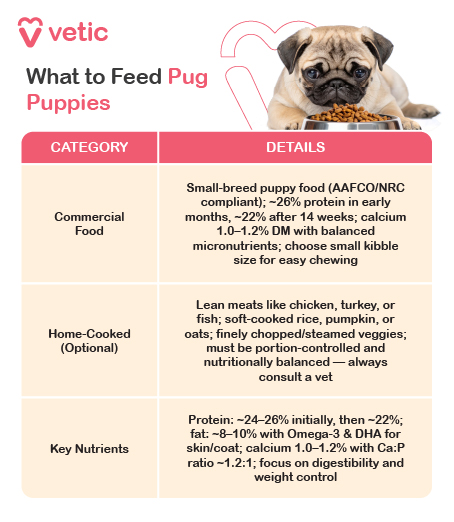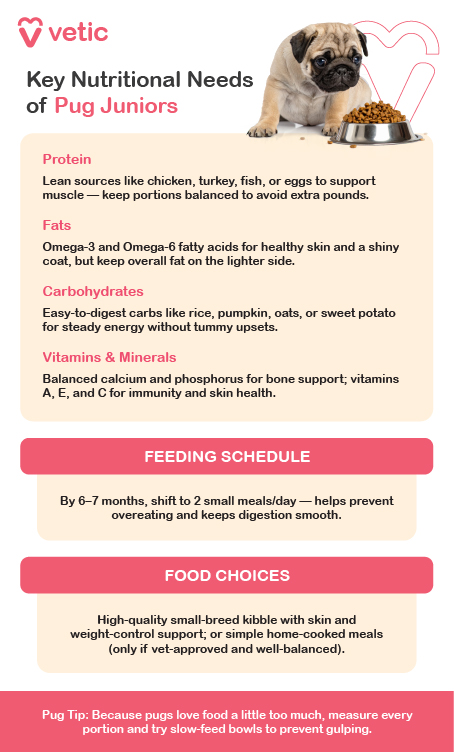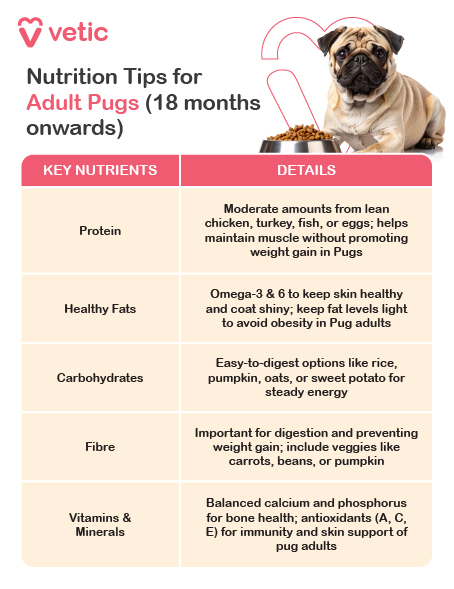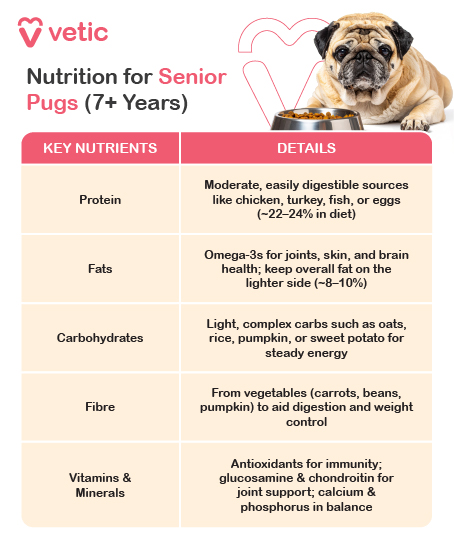Pugs are one of those breeds that win you over instantly with their big, soulful eyes and mischievous personalities. But behind their playful charm, they come with very specific needs when it comes to food and feeding. Because of their brachycephalic (short-nosed) faces, uneven dentition, love for eating, and low tolerance for exercise, nutrition plays a critical role in keeping them healthy. So, do you know what to feed your pug as per their lifestage?
What works for a growing Pug puppy is not the same as what works for an adult or a senior Pug. Their needs change as they age, and a mindful approach to diet can make a real difference to their quality of life.
Let’s take a closer look at Pugs through every life stage, focusing on their nutritional necessities, food options, and best feeding practices.
What to Feed Your Pug Puppy?
When your Pug is still a puppy (0 to 12 months old), they are full of curiosity and bursts of energy. Their bodies are growing quickly, which means their food has to work extra hard to support development.

Nutritional Necessities of Pug Pups
Pug puppies need diets that are rich in protein and healthy fats. Protein builds strong muscles, while fat fuels their rapid growth and gives them energy for play. Because brain and eye development are still happening, nutrients like DHA and EPA are particularly important. However, despite their playful nature, Pugs tire quickly due to their short muzzles and breathing limitations. This means they don’t burn calories as efficiently as other breeds. Overfeeding during puppyhood can easily lead to fat buildup, so balanced energy intake is key.
At this age, their skin is also delicate. Adding omega-3 and omega-6 fatty acids early in their diet helps strengthen the skin barrier and may reduce the risk of dermatitis later on. Since puppies can have sensitive tummies, easily digestible proteins and prebiotics make digestion smoother and keep gas or loose stools under control.
Food Options for Pug Puppies
Breed-specific puppy kibbles are ideal because they are designed with the short noses of brachycephalic dogs in mind. The pieces are usually small, flat, or puffed, which makes them easier for puppies to pick up and chew despite their crowded teeth. Wet food can also be introduced for extra hydration and to soften meals, especially if chewing is a struggle. For families who prefer homemade food, a mix of lean meats, rice or oats, and vegetables can work, but this should always be fortified with calcium and vitamins under veterinary supervision.
Feeding Practices
Feeding frequency is very important for puppies. Instead of one or two large meals, it’s better to divide their food into three or four small meals a day. This prevents their little stomachs from being overloaded and keeps their energy steady. Portion control is critical right from the beginning because Pugs love food and rarely stop when they are full. Feeding them in puzzle bowls or slow feeders can prevent gulping, which in turn reduces the risk of choking or regurgitation. And of course, fresh water should always be available.
What to Feed Your Pug Juniors (1–2 years)?
Once your Pug transitions out of puppyhood, their growth begins to stabilize. They are no longer rapidly developing, but their bodies are still filling out. This stage can be tricky because it’s often when Pugs first show signs of weight gain.

Nutritional Necessities of Pug Juniors
During adolescence, energy requirements start to taper off compared to the puppy stage. Protein continues to be necessary for maintaining muscle tone, but calorie intake needs to be watched closely. Pugs at this age often put on weight very quickly if portions are not measured carefully. Their skin can also become more sensitive as hormones are active, so omega fatty acids, vitamin E, and zinc remain vital in the diet. Dental concerns can also come into play here; if their teeth are crowded, hard or oversized kibble may not be chewed properly, leading to discomfort or even skipped meals.
Food Options
A transition formula that bridges the gap between puppy and adult food works well. These usually provide moderate fat levels and balanced energy density. A combination of dry kibble and wet food can help — the dry component maintains dental health while the wet component improves palatability and hydration. Healthy snacks are also useful at this age, especially for training, but they must be low in calories. Carrot sticks, apple slices (without seeds), or small vet-approved treats make good options.
Feeding Practices for Your Pug
By this age, Pugs should be moved to two meals a day. Since their exercise tolerance is naturally low, their calorie intake should match their activity levels to avoid unwanted weight gain. Feeding practices should also take into account their dental challenges. If their teeth are crowded or chewing seems uncomfortable, kibble can be slightly softened with warm water or broth to make it easier to eat without compromising nutrition.
What to Feed Your Pug Adult?
Adulthood is when Pugs are at their prime (between 2 and 7 years), but it’s also the stage when their predisposition to obesity, skin issues, and joint strain becomes more apparent.

Nutritional Necessities for Adult Pugs
Weight management becomes the number one priority. Even a couple of extra kilograms can worsen their breathing and put stress on their joints. Diets should focus on lean protein, moderate fat, and controlled calories. Skin and allergy care are equally important at this stage. Many adult Pugs develop itchy skin or dermatitis, so foods enriched with omega-3 fatty acids, vitamin E, and digestible proteins help reduce flare-ups. Digestive comfort should not be overlooked either — fiber and prebiotics can ease flatulence and keep stools regular. Lastly, nutrients like glucosamine and chondroitin are useful for protecting the joints that bear the load of their compact but heavy frames.
Food Options for Pug Adults
Adult small-breed formulas are usually the best choice, as they are designed for calorie balance and easy chewing. Wet food can be given in moderation to boost hydration and flavor, but it should be paired with regular dental care to prevent plaque buildup. For those who prefer home cooking, lean meats such as chicken or turkey combined with vegetables and grains like rice or oats can work well, but they must be fortified with appropriate supplements to ensure the diet is complete.
Feeding Practices
Two meals a day remain the norm for adult Pugs. Using slow-feeder bowls continues to be helpful in preventing rapid gulping. Portion control is essential, and weight should be monitored regularly since even small fluctuations can have a big impact on their health. Because Pugs struggle with cooling themselves through panting, hydration becomes even more important, especially in warmer months. Fresh water must always be accessible.
What to Feed Your Senior Pugs (7+ years)?
By the time a Pug reaches their senior years, their pace of life naturally slows down. They may not be as playful as they once were, but they still rely on good nutrition to stay comfortable and happy.

Nutritional Necessities
Senior Pugs require fewer calories because of their reduced activity levels. Overfeeding at this stage can quickly lead to obesity, which in turn worsens breathing problems and strains aging joints. Joint health now becomes a central focus, with supplements like glucosamine, chondroitin, and omega-3 fatty acids helping to keep them mobile. Digestion often becomes weaker in older age, so diets higher in fiber and made with highly digestible proteins work best. Their immune systems also need extra support, which is where antioxidants like vitamins C and E play an important role. Dental issues are common in senior Pugs, with many losing teeth or experiencing gum pain, so softer textures are often needed.
Food Options
Senior-specific dog foods are ideal because they are lower in calories but enriched with joint and immune-support nutrients. Moist or softened kibble is often easier for older Pugs to manage, especially if chewing has become painful. Homemade diets can also be tailored for seniors, with lean proteins, vegetables, and the right supplements to match their changing needs.
Feeding Practices
Two small meals a day are still recommended, but the portions should be lighter to ease digestion. Kibble can be softened with warm water or broth if chewing is difficult. Seniors also do well with predictable meal routines, as consistency reduces anxiety and helps them feel secure. Regular veterinary checkups are essential at this stage, as diets may need to be adjusted for age-related conditions such as kidney or heart disease.
Final Thoughts about Pug Food and Nutrition
Feeding a Pug is never just about filling the bowl. It’s about understanding how their unique anatomy and temperament shape their relationship with food. From puppies who need nutrient-dense diets but careful portioning, to adults who must avoid obesity, and seniors who thrive on softer, joint-friendly meals, each life stage comes with its own challenges. What remains constant, though, is the need for portion control, skin-supporting nutrients, and feeding practices that make eating safe and enjoyable for a brachycephalic breed.
When done right, nutrition can add years of comfort and vitality to a Pug’s life. These little dogs may not be able to run marathons, but with thoughtful feeding, they can continue filling your home with joy, love, and their signature goofy charm well into their senior years.
FAQs on Feeding and Nutrition for Pugs
1. How often should I feed my Pug?
Feed adult Pugs twice daily in measured portions to control weight and support digestion. Puppies need three to four small meals.
2. What type of kibble works best for Pugs?
Choose small, flat, or brachycephalic-specific kibble that’s easy to pick up, chew properly, and prevents gulping due to short muzzles.
3. Can Pugs eat homemade food safely?
Yes, but meals must include lean meats, grains, vegetables, and vet-prescribed supplements to ensure balanced, complete nutrition.
4. Are Pugs prone to food allergies?
Yes, Pugs often show skin issues linked to allergies. Diets with omega fatty acids, digestible proteins, and minimal fillers help.
5. Should I give my Pug wet food daily?
Wet food helps hydration and chewing comfort, but balance with dry food or dental care to avoid excessive plaque and tartar.
6. How do I prevent my Pug from overeating?
Use slow-feeder bowls, measure portions carefully, and limit treats. Free-feeding is unsafe since Pugs rarely regulate food intake themselves.
7. What supplements are beneficial for Pugs?
Omega-3 fatty acids for skin, glucosamine and chondroitin for joints, and antioxidants for immunity are excellent for lifelong health.
References:
American Kennel Club. (n.d.). Pug dog breed information. American Kennel Club. https://www.akc.org/dog-breeds/pug/
Becvarova, I., & Gates, C. (2020). Obesity prevention and management in dogs and cats. Veterinary Clinics of North America: Small Animal Practice, 50(6), 1209–1225. https://doi.org/10.1016/j.cvsm.2020.07.003
National Research Council. (2006). Nutrient requirements of dogs and cats. Washington, DC: The National Academies Press. https://doi.org/10.17226/10668
Royal Veterinary College. (2019). Obesity in Pugs: Risk factors and prevention. Royal Veterinary College, University of London. https://www.rvc.ac.uk/vetcompass
VCA Animal Hospitals. (n.d.). Feeding your dog for optimum health. VCA Animal Hospitals. https://vcahospitals.com/know-your-pet
WSAVA Global Nutrition Committee. (2021). Global nutrition guidelines. World Small Animal Veterinary Association. https://wsava.org/global-guidelines/global-nutrition-guidelines/

